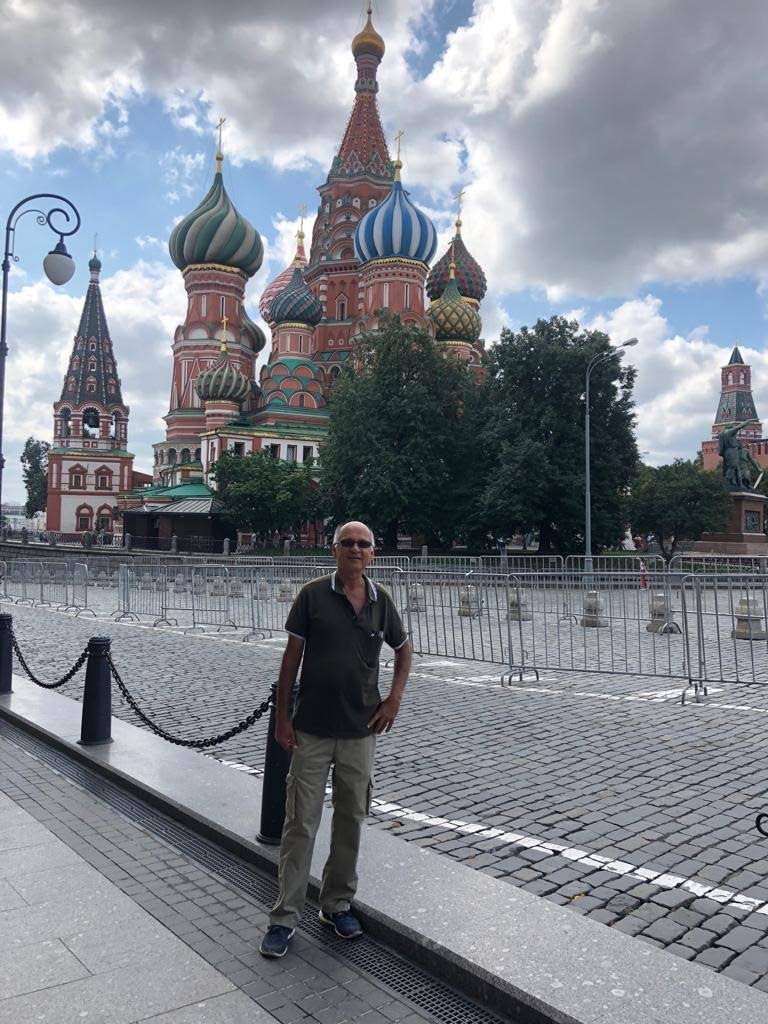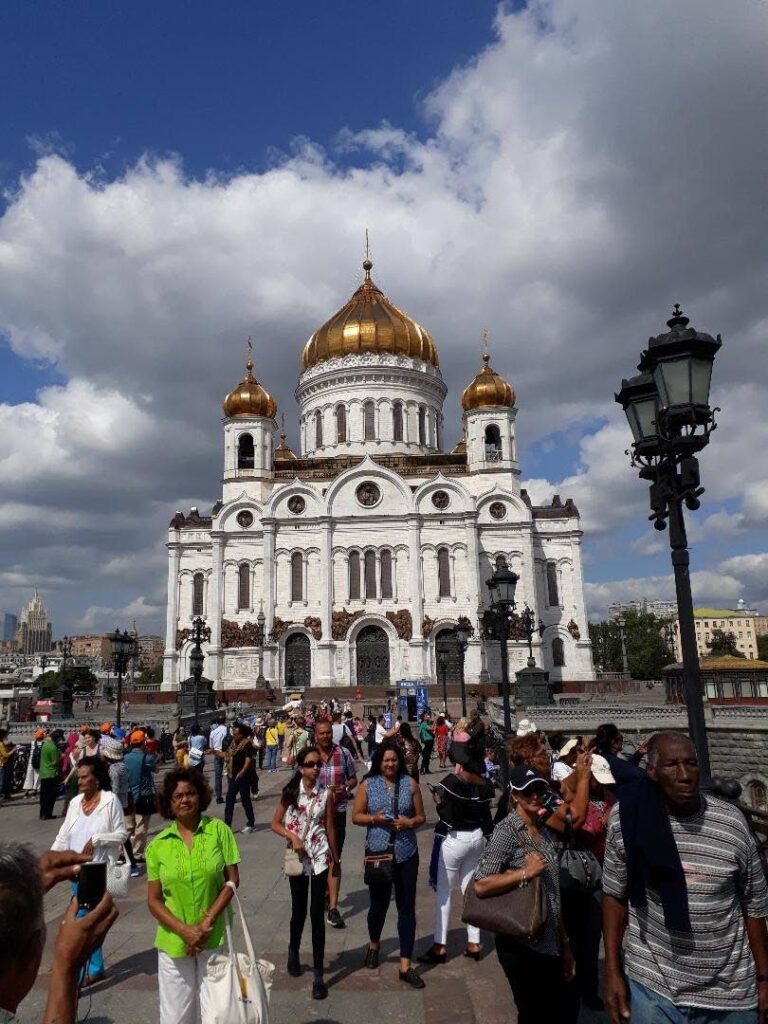A Trini's travels in Russia before war

Jan Westmaas
To say that the combined effect of the pandemic and the Russian invasion of Ukraine dealt foreign travel a nasty blow is to state the obvious. Personally, I can hardly think of a year since the late 60s when I was just getting out of my teens that I had not ventured abroad. Whether travelling by myself, with my family or accompanying groups on tours to Latin America, the French and Spanish-speaking Caribbean, or Europe and North and South Africa, leaving our shores at least once a year had become a matter of course, if not compulsion.
Then came covid. In 2020, I had no choice but to cancel all five of my group tours, all fully booked, to wit: north-east Brazil from Salvador (Bahia) to Belem (2,000 kms by coach), the Mayan regions of the Yucatan (Mexico) which my wife and I first visited in 1975, Peru including Machu Picchu (first visited in 1974 on a two-month overland honeymoon adventure from Venezuela), a French student tour to Martinique and, finally, an eco-themed tour of Costa Rica.
I roll with the punches as I reminisce on the successes of our group outings the two years (2018 and 2019) prior to the pandemic. Naturally, with Russian President Vladimir Putin spitting venom and unleashing his vengeful “dogs of war" on neighbouring Ukraine, time and again my mind has drifted to our Russian tour of July 2018.
After a Condor Airlines flight from Tobago to Frankfurt, Germany, our group of 41 Trinis journeyed by coach for 19 days to Moscow and back with an overnight crossing of the Baltic by ferry (Stockholm to Helsinki). En route we toured seven western, central and eastern European nations – Germany, Denmark, Sweden, Finland, Russia, Belarus, Latvia and Poland – where we made it our business to visit Auschwitz, the killing fields of another autocrat, the German Nazi, Adolf Hitler.
As I shed more than a tear for battered, beleaguered but by no means vanquished Ukraine, I recall at the same time, from my vantage point on the expansive and soulless Red Square, the magnificence of the multi-onion-domed St Basil’s Cathedral. Symbol of the Russian Orthodox (Christian) faith, it was built by Czar Ivan the Terrible in the middle of the 16th century.
Still finding it difficult to wrap my mind around the 21st century autocrat who I have deemed “Vladimir the Butcher", my mind turns to our visit to another Russian Orthodox Church – the Cathedral of Christ the Saviour. It’s a mere few hundred metres south-west of the Kremlin. It was rebuilt in the early 90s shortly after the era of Perestroika and Glasnost that led to the break-up of the Soviet Union and the virtual collapse of communism. It is the third largest Christian Orthodox church in the world and is indeed an imposing, impressive structure with an interesting history. It was originally built between 1839 and 1883 by another czar, Alexander I, to celebrate Russia’s defeat of Napoleonic France in the Patriotic War of 1812. Czardom and Russian Church Orthodoxy never ended.
Only recently I learnt that our guide had failed to tell us that Russian feminist punk rock group Pussy Riot had staged a protest in the church in 2012 against the Russian Orthodox Church’s support for the Russian President and former head of the KGB, Vladimir Putin. Three members of the group were subsequently arrested and jailed. It may sound cynical but the Orthodox Church clearly knew where its bread was buttered.

That’s enough of Russia for the moment. Heaven knows when and how its conflict with Ukraine will end. Meanwhile, even though in the latter stages of the pandemic, many countries including ours, have been opening up to foreign leisure travel, I had my reservations. I thought 2024 seemed a more realistic time frame for the resumption of travel.
In the interim, our son Timothy and Polish daughter-in-law, Kasia, offered us an all-expenses paid trip in March/April of this year to their home in Kingston-upon-Thames, London. We had the necessary covid vaccinations and boosters. We just had to hope and pray that our antigen tests, administered 48 hours before returning to Trinidad, were negative. It was an offer too good to refuse. We had not seen them nor our grands (two precious girls Amelia, 10, and Ella, four) since they visited us in Trinidad in 2018. To facilitate us, Timothy, took vacation leave while Kasia was able to work from home for some days during our stay. “Do you have a kid?” Ella asked. “No”, I replied. “Well, I can be your kid,” she responded. I knew instantly what was in store for us.
If I ever deluded myself to believe that I was “the” master tour planner, having travelled extensively over so many years, I humbly bestow this honour on Tim and Kasia. They made sure that things moved smoothly, ensuring all the time that family came first. Both are committed to physical fitness. Kasia runs, rides and hikes as does Tim. And their daughters are an integral part of the fun.
Tim and Kasia knew us well. They were fully aware that before we left Trinidad for London on March 31, we had both been walking/running almost daily for at least an hour. The way they planned the tour, they obviously took this into account. We arrived at Gatwick in mid-morning on April 1 to be greeted by a flurry of snow.
From the day we arrived, it was obvious that our interests, which blended so seamlessly with theirs, were paramount. Their home is but a 15-minute walk from Richmond Park, one of London’s eight royal parks. It covers an area of 2,500 acres of grasslands with herds of deer in the wild, forests and many wide, open spaces.
Criss-crossed by partly undulating trails, gravel, earthen or tarmac, Richmond Park, apart from its obvious attraction to naturalists, is paradise for ramblers, walkers, runners and cyclists. Hardly a day passed without all six of us – parents, grandparents and grandchildren – exploring some part of the park. We were either on foot, bicycle or at times, as in Ella’s case, when the going got tough, on her Dad’s shoulders, while he walked briskly or jogged.
Clearly, the high point of our first two days in London was our exploration on foot of Richmond Park and, not to be ignored, was our walk at some pace to shop in downtown Kingston.
“We’re all off tomorrow to mid-Wales for a few days," Tim blurted out. It took me by surprise. I had forgotten that Tim and Kasia had rented a holiday home for a few days in Capel Bangor, a village near Aberystwyth, where we lived for three years (1983-1986) while I studied at the local university. Tim was nearly five when we returned to Trinidad. Neither he nor we had been back to that village since we left in 1986. We looked forward to seeing what the Welsh village that had virtually adopted us as family looked like.
Being a party of six meant that we had to do the five-hour road trip to Capel Bangor in two cars. Christine drove with Kasia in her BMW and I travelled with Tim in his 10 year old Volvo, with the two girls at the back in their car seats. As planned, we were off by 9 am. We headed west, quickly got on to the M4, by-passed Reading, Swindon and Bristol and in less than two hours, we had reached the bridge over the Severn river that demarcates the boundary between England and Wales. His eyes on the road, he eagerly responded to the questions I posed to him about the politics of Great Britain, his adopted country. He brought me up-to-date on the latest shenanigans of Boris Johnson and the Conservative party, the leadership issues in the Labour party and the effects of Brexit on the country.
Off the motor way, before reaching deep into the Welsh countryside, we drove through the stunningly beautiful Brecon Beacons National Park where Tim and family had gone hiking some time ago. Road signage was, as expected, bi-lingual (Welsh and English). Soon sign boards with the names of villages and places I recall from the 80s, came into view: Abergavenny, Built Wells, Rhyader, Llanidloes, Llangurig, Devil’s Bridge and finally, Goginan. Capel Bangor was now within reach. I was thrilled.
We finally reached our destination, a bungalow, tucked neatly away from the A44 main road on a sheep farm. Tim and Kasia could not have made a better choice of accommodation for the four nights we spent in Wales. It turned out to be a three-bedroom holiday home with en suite bathrooms, a spacious kitchen and living room and a conservatory with a clear view on three sides of the surrounding sheep farms and of the manse (vicar’s house) in which we lived in my final year at the university.
The bungalow was also within easy reach of the places in the village that mattered most to us- the first house and the community we lived in 39 years ago and the primary school which our children attended. Our elder daughter, Nadia, who paid a nostalgic visit to Capel Bangor with her husband and young son in 2012, had told us that very little had changed. She was six when we returned to Trinidad in 1986 and spoke Welsh like a native.
Jan Westmaas is author of Out of the Box, Tales of Travel (1972-2013). It’s available as an e-book on Amazon, or e-mail the author at westmaastouring@yahoo.com


Comments
"A Trini’s travels in Russia before war"